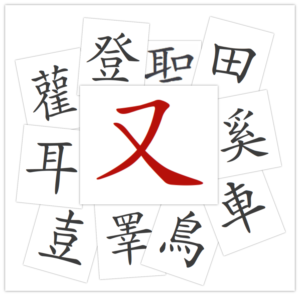 Simplified characters have fewer strokes, which makes them simpler, right? A character with fewer strokes is faster to write, of course, but does that also make it easier to learn? This is a question I think most people who have learnt at least some characters from both sets have asked themselves, but which isn’t easy to answer.
Simplified characters have fewer strokes, which makes them simpler, right? A character with fewer strokes is faster to write, of course, but does that also make it easier to learn? This is a question I think most people who have learnt at least some characters from both sets have asked themselves, but which isn’t easy to answer.
In this article, Ash Henson from Outlier Linguistics attempts to bring clarity to the traditional vs. simplified debate. Ash is a PhD candidate in Chinese palaeography (the study of historic writing systems) and CTO at Outlier Linguistics. If you want to learn more about Ash, I interviewed him for my article about the Outlier Chinese Character Dictionary.
愛, the traditional version of the character for ài “love” is noticeably superior to the simplified version, 爱, because 愛 has 心 “heart” in it. How can you have love without a heart?
I bet at this moment, you’re pretty clear on which camp you’re in when it comes to the traditional vs. simplified debate. If the former, then you’re probably beaming with pride, and if the latter, red in the face.
When it comes to the debate between whether simplified characters are superior to traditional or vice versa, there is far too much emotion. The proof of this, is that the top of both traditional 愛 and simplified 爱 is ![]() , which is meaningless. It’s not related to 爫 zhǎo “claw” nor to 冖 mì “cover.” It’s simply a corruption of an earlier form.1 Neither the pro-Traditional, nor the pro-Simplified camp ever seem to notice that.
, which is meaningless. It’s not related to 爫 zhǎo “claw” nor to 冖 mì “cover.” It’s simply a corruption of an earlier form.1 Neither the pro-Traditional, nor the pro-Simplified camp ever seem to notice that.
How could both sides of the debate ignore this very important detail? Probably because they’re too busy trying to prove their side. By the way, the simplified camp can retort, “But it has 朋友的友! Isn’t that the same?” to the no-heart statement.
A brief history of simplified characters
I’m not going to argue here for the superiority of either type of character. I just want to try and set up a rational basis for comparison. Then, of course, we’ll have a little fun at the expense of traditional characters, and then turn the lens onto simplified characters and have some fun there too. While we’re talking about simplified characters, I’d like to offer some alternatives to some of the common simplifications.
One important thing to consider is “Why were characters simplified to begin with?” Ideas for modern simplification started out in the 1800’s, though characters have had simplified and complex forms for thousands of years. When Europeans showed up in Asia in the 1600’s, they surprised China with their military and technological advances.
Chinese intellectuals pondered the question of how this could have happened and one of the answers they proposed was that the Chinese language itself was backward. One scholar even proposed doing away with it entirely in favor of adopting Esperanto!
(I often daydream about what it would have been like to be a government bureaucrat tasked with going into a farming village to explain to the people that they would have give up the language they’ve been speaking their whole life in order to adopt Esperanto – perhaps there would be a chéngyǔ now meaning “to get tarred and feathered” had that actually happened).
Does more strokes mean that a character is harder to learn?
The high levels of literacy in Taiwan and Hong Kong, however, show definitively that the language itself was not the problem. Access to education was the problem. Since native character learning education is often based upon writing and re-writing, the idea was that lowering stroke count would make the writing system simpler.
Let’s look at some traditional characters that may have given them the impression that stroke count was simply too high. But, there is more to the story than simply stroke count. Take ![]() zhé (or tiè) “verbose” for example. It has a whopping 64 strokes! But, it’s structure is rather simple. If you know how to write 龍 lóng “dragon,” then you just write it four times in a symmetrical pattern. So, while
zhé (or tiè) “verbose” for example. It has a whopping 64 strokes! But, it’s structure is rather simple. If you know how to write 龍 lóng “dragon,” then you just write it four times in a symmetrical pattern. So, while ![]() has a huge number of strokes, it’s actually quite easy, albeit a bit tiring, to write and remember. It may bring you some comfort that you’ll probably never need to write
has a huge number of strokes, it’s actually quite easy, albeit a bit tiring, to write and remember. It may bring you some comfort that you’ll probably never need to write ![]() unless you’re having a discussion about high stroke counts.
unless you’re having a discussion about high stroke counts.
What makes a successful character simplification?
In order to judge whether a particular simplification is successful or not, we need to ask ourselves, “Why do characters exist in the first place?” The answer to that is obviously “to represent Chinese visually.” In other words, to give a visual representation to a spoken Mandarin word. Spoken words are sound-meaning combinations.
So, the better a visual symbol can represent sound and meaning, the more valuable it is as a written symbol. Of course, there are other questions one could ask as well, such as “Is it easier to learn?” “Is it easier to read?” etc. But having said that, sound and meaning representation is a good place to start.
Characters with high stroke counts are sometimes easy to understand and learn
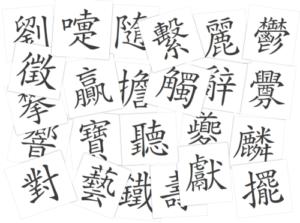 As I mentioned before, there have been simplified forms of characters virtually for as long as there have been characters. The correct way to understand the term “simplified forms” here is “forms which are written with fewer strokes,” not to be mistaken with “conceptually more simple.” I’m taking a liberty with the word “strokes” here as “strokes” as they are interpreted today did not exist in early writing. Another way of saying that is that any and all lines or shapes were acceptable in early writing.
As I mentioned before, there have been simplified forms of characters virtually for as long as there have been characters. The correct way to understand the term “simplified forms” here is “forms which are written with fewer strokes,” not to be mistaken with “conceptually more simple.” I’m taking a liberty with the word “strokes” here as “strokes” as they are interpreted today did not exist in early writing. Another way of saying that is that any and all lines or shapes were acceptable in early writing.
So, why are we even faced with the Simplified vs. Traditional dichotomy? Mostly due to characters like these:
鬱 龜 聽 贏 辭 響 攀 麟 對 隨 擔 徵 劉 鐵 藝 寶 麗 釁 嚏 擺 獻 觸 夔 壽 襯 繫
To the untrained eye, these would all appear to be equally difficult, but there is a vast difference in difficulty represented here. For instance, look how easy these are to understand:
- 麟 lín (orig.) “a large female deer”
= 鹿 “deer” + 粦 lín (think of this as “the word that sounds like lín and whose meaning is similar to ‘deer’.”) - 響 xiǎng (orig.) “echo”
= 鄉 xiāng + 音 “sound” - 擺 bǎi (orig.) “to separate, eliminate”
= 扌“hand; actions with the hand” + 罷 bà - 觸 chù (orig.) “for a bull to gore/strike s.o. with its horns”
= 角 “horn” + 蜀 shǔ - 襯 chèn (orig.) “a type of shirt”
衤“clothing” + 親 qīn - 繫 jì (TW: xì) (orig.) “low quality cotton”
𣪠 jī + 糸 “silk threads; having to do with textiles”
Regardless of their stroke count, each of these characters is very easy to understand given that you already know the components involved. The real difficult ones are these:
- 鬱 yù (orig.) “lush vegetation”
=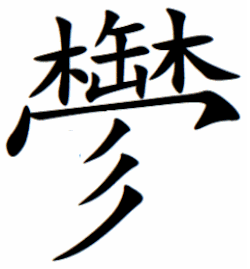 yù “lush vegetation” + 鬯 “fragrant liqour” (implying “lush”)
yù “lush vegetation” + 鬯 “fragrant liqour” (implying “lush”)
The reason 鬱 is so difficult is not due to the number of strokes, nor to its structure, rather, the use of , which is not commonly used, does not appear as a character in its own right in modern Mandarin, and it has an unusual structure.
, which is not commonly used, does not appear as a character in its own right in modern Mandarin, and it has an unusual structure. - 攀 pān (orig.) “to climb over a fence”
= 樊 fán “to climb over a fence” + 手 “hand; actions done with the hand”
Once again, the structure isn’t difficult. What makes 攀 difficult is the use of 樊, which is quite rare in modern Mandarin. - 龜 guī (orig.) “tortoise; turtle”
If that doesn’t look like a turtle, what about now: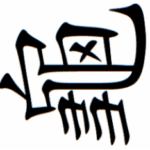 ? The head is on the left, and the tail on the right. The feet are the fork-looking things on the bottom, and the shell is the box with an X on it. If you want to impress Chinese speakers, learn to write this character correctly! What makes it difficult is the large number of strokes and that most people don’t try to connect it to an actual turtle in their mind. If you do that, it’s a little easier to remember.
? The head is on the left, and the tail on the right. The feet are the fork-looking things on the bottom, and the shell is the box with an X on it. If you want to impress Chinese speakers, learn to write this character correctly! What makes it difficult is the large number of strokes and that most people don’t try to connect it to an actual turtle in their mind. If you do that, it’s a little easier to remember. - 聽 tīng (orig.) “to listen”
耳 “ear” + 𡈼 tǐng + 㥁 dé.
What makes this character difficult is the use of 𡈼 tǐng as a sound component. It is not a common component and it looks very similar to 壬 rén. The main difference being the length of the middle horizontal stroke. It’s short for tǐng and long for rén. Another reason is the seemingly extraneous use of 㥁 dé as a second sound component, itself not in common use and the sound connection is anything but obvious in Mandarin. - 對 duì (orig.) “to pack dirt by pounding it down”
丵 “chisel-like instrument” + 土 “dirt” + 寸 “hand; actions done with the hand”.
The structure isn’t difficult, but the fact that 丵 is uncommon combined with the fact that it is written together with 土, making the two look like a single component, adds to the difficulty.
How simple are simplified characters?
Now that we’ve had some fun with traditional, let’s take a look at simplified: the good, the bad and the ugly. For this part of the discussion, we’re only going to look at some of the core simplifications, which is about 500 characters in total.
No, we aren’t going to look at all of them! What are “core simplifications”? For instance, 扩 (擴) would not be considered a core simplification, because the real simplification was 廣 -> 广. If you understand that 广 is 廣, then 扩 makes just as much sense as 擴.
Let’s define what makes a successful simplification:
A successful simplification is any simplified character that represents sound and meaning at least as well as its traditional counterpart.
For instance, 張 zhāng (orig.) “to pull a bow string taut” is composed of 弓 “bow (for shooting arrows)” and 長 zhǎng (also cháng). The simplified character, 张, is composed of 弓 “bow (for shooting arrows)” and 长 zhǎng (also cháng).
Just looking at this from the perspective of this single character, 张 represents the sound and meaning of zhāng (orig.) “to pull a bow string taut” just as well as 張, so 张 is a successful simplification.
An unsuccessful simplification, then, is one that doesn’t meet the definition of a successful simplification. To state it more obviously:
An unsuccessful simplification is one that doesn’t represent the sound and meaning as well as the traditional counterpart.
Take 際 jì “boundary,” which is composed of 阝(阜) “hills; something that separates” + 祭 jì. The corresponding simplified character, 际, is composed of 阝(阜) “hills; something that separates” + 示 shì “to show.” 示 and its component form 礻are used to give meanings related to religion and the spirit world, so it wouldn’t make sense as a semantic component. Here, 示 is a graphical abbreviation of 祭, so 际 does not represent sound and meaning as well as 際.
That is the basic framework for making a methodical comparison between the two systems: does the simplified form represent sound and meaning at least as well as the corresponding traditional character?
Simplified characters as shortcuts vs. learning simplified from scratch
There is another aspect which is important to consider: there is a big difference between Person A who knows 際 and is clear on its structure writing 际 as a shortcut vs. Person B who only knows 际 and doesn’t know that 示 is a shortcut for 祭.
Remembering and recall for this character will be easier for Person A, who can use the logic of sound and meaning representation, while Person B is left to rote memorization because they can’t take advantage of functional components. Person B could still make a memory story, though to create their own meaning, but that isn’t as powerful as creating a story based on the character’s baked in logic.
There are many other aspects that could be considered as well. Characters like 車 (T) are easier to remember than 车 (S) due to the symmetry of 車 and the asymmetry of 车. Or, take similar components like 易 vs. 昜 (both T), which make it easy to mistake characters like 錫 and 鍚, though 锡 and 钖 (both S) are not easy to confuse.
Having said that, if you know that a character with 易 will have the rhyme -i, while one with 昜 will have the rhyme -ang, then they are easier to keep separate. Take 言 in traditional vs. 讠, 言 in simplified. Of course there are less strokes in 讠 than in 言, but at the cost that you now have to remember both 讠 and 言 as well as when to use which.
When simplified characters really aren’t simpler to understand
One of the main causes of unsuccessful simplifications is cǎoshū kǎihuà (草書楷化/草书楷化), literally translated: “The regular-script-ification of cursive script”. A common example given for this is the seemingly overuse of 又 as graphical simplification for a complex character component:
| T | S |
| 漢 | 汉 |
| 難 | 难 |
| 歡 | 欢 |
| 權 | 权 |
| 樹 | 树 |
| 鄧 | 邓 |
| 戲 | 戏 |
| 雞 | 鸡 |
| 釋 | 释 |
| 澤 | 泽 |
| 聖 | 圣 |
| 攝 | 摄 |
| 鳳 | 凤 |
| 轟 | 轰 |
| 疊 | 叠 |
So, 又 can be used as graphical abbreviation for such diverse components as:
、
、雚、壴、登、䖒、奚、the top half of 睪、
、耳、鳥、車、田
It’s not hard to see that this can be damaging to the representation of sound and meaning. In fact, if you’re learning simplified, for this type of character, I recommend learning the traditional form (which still has its logic intact), then attaching the simplified form to that in your mind.
Like, take 车 as a simplification for 車 as example. Due to its symmetry, 車 is very easy to remember. Use it as your basis for remembering 车 by seeing how 车 is a graphical simplification of 車 (see image from the Outlier Dictionary of Chinese Characters on the right).
Another example is 过 as a simplification of 過 guò “to pass through,” composed of 辶 “foot walking along a road” + 咼 guō. 寸 is a graphical abbreviation of 咼 (see image from the Outlier Dictionary of Chinese Characters on the right).
Learning in this way, you can use the traditional form as an anchor for remembering the simplified form. Of course, this only makes sense in cases where the traditional form has a clear, simple structure and the simplified form has a broken structure, like 过. If this seems like too much work, then use this technique only on the ones you’re having difficulty with.
How simplified characters could have been simpler to learn
Some of the simplifications could have been made better with just a little more thought. Here are a few examples:
- The simplification of 聽 tīng “to listen” is 听: 口 “mouth” + 斤 jīn.
Why not use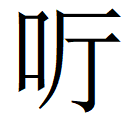 instead? 口 “mouth” + 厅tīng
instead? 口 “mouth” + 厅tīng - The simplification of 團 tuán (orig.) “round” is 团: 囗 “border” + 才 cái. Where 才 is simply a graphical abbreviation of sound component 專 zhuān. Why not go with
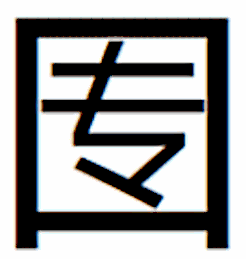 : 囗 “border” + 专 zhuān?
: 囗 “border” + 专 zhuān? - The simplification of 盤 pán (orig.) “tray; platter,” composed of 般 bān + 皿 “dish; container” is 盘, which is 舟 “boat” + 皿 “dish; container.” Why not go with
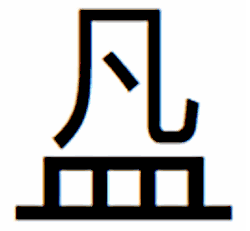 : 凡 fán + 皿 “dish; container.” Interestingly, the 舟 in 般 actually is a corruption of an earlier 凡.
: 凡 fán + 皿 “dish; container.” Interestingly, the 舟 in 般 actually is a corruption of an earlier 凡. - 劉 liú (orig.) “type of weapon; to kill,” composed of 卯 mǎo + 金 “metal” + 刂 “knife.” Note that 卯 is also sound component in 留 liú, 貿 mào, 聊liáo, 柳 liǔ, etc. The simplification of 劉 is 刘: 文 wén “writing” + 刂 “knife.” 文 is a graphical abbreviation of the left side of 劉. Why not go with
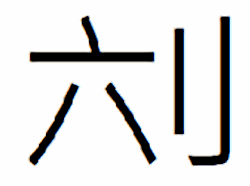 : 六 liù + 刂 “knife”?
: 六 liù + 刂 “knife”? - 導 dǎo (orig.) “to lead, guide” is composed of 道 dào + 寸 “hand; actions done with the hand; action.” It’s simplified form is 导: 巳 sì “6th Earthly Branch” + 寸 “hand; actions done with the hand; action.” Here, 巳 is a graphical abbreviation of 道. Why not go with
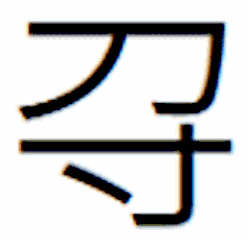 : 刀 dāo + 寸 “hand; actions done with the hand; action.”
: 刀 dāo + 寸 “hand; actions done with the hand; action.”
There actually is an answer to “Why not go with…” and that is that the people in charge of simplification were afraid that the public may not accept their changes if they were too radical. This is why the vast majority of simplifications are previously attested in Chinese history.
Learning simplified and traditional characters
Whether you’re learning traditional or simplified, you will come across some characters that are very difficult to make sense of. It’s best to have a plan on how to deal with them.
Of course I’m biased, but I recommend the Outlier Dictionary of Chinese characters as it is designed to explain why each character looks the way it does, bringing clarity to your learning.
Conclusion
I don’t have a definitive answer to the traditional vs. simplified debate, but of the core 500 simplified characters, 108 of them have either broken or degraded sound components, for a total of 21.6% of them, though not all of the core 500 are sound-meaning characters.
Another measure is the number of empty components. Within the Outlier data for traditional, there are 293 empty components for 2769 total characters or 10.58%, while for simplified there are 393 empty components for a total of 2654 characters or 14.8%. Interpret that as you wish, but to truly solve the riddle, systemic issues need to be taken into account as well, which has not been done here.
Now, hopefully, we can at least have more meaningful conversions within the traditional vs. simplified debate and not get stuck on things like “fewer strokes is necessarily more simple” or that 爱 (S) doesn’t work simply because it doesn’t have 心 “heart.”
 A big thank you to Ash for writing this guest article! This is not the end of the debate, but it’s a good attempt to bring some rationality to it. Some simplified characters really are quicker to write without being any harder to understand and learn, but not all! And some traditional characters may have a large number of strokes without being difficult to remember.
A big thank you to Ash for writing this guest article! This is not the end of the debate, but it’s a good attempt to bring some rationality to it. Some simplified characters really are quicker to write without being any harder to understand and learn, but not all! And some traditional characters may have a large number of strokes without being difficult to remember.
This article contains many character analyses that can greatly aid you in your quest to learn to read and write Chinese characters. I strongly recommend that you check out the Outlier Chinese Character Dictionary if you haven’t already!
Footnotes
- If you’re a purist and are thinking, “Why call it ‘corruption’? It’s such a negative term and language change is neutral after all!” I’m using the English translation of the Chinese term 訛變 ébiàn, which is what this type of change is called among Chinese-speaking paleographers. Also, while it is true that changes to word meanings and such are neutral, changes to characters are not always neutral. There are changes that negatively affect a character’s ability to represent sound or meaning. Ex. 封 fēng was originally composed of 丰 fēng “seedling” over 土, a pile of dirt, meaning “to plant trees to indicate the border between two pieces of land.” Later, 寸 “hand” was added to emphasize the action. The “seedling” and “dirt” came to be written 圭 guī “type of jade tablet.” It’s easy to see that the change from 丰 fēng + 土 “dirt” to 圭 guī obscures the sound and meaning representation of 封 fēng. Go back to text.
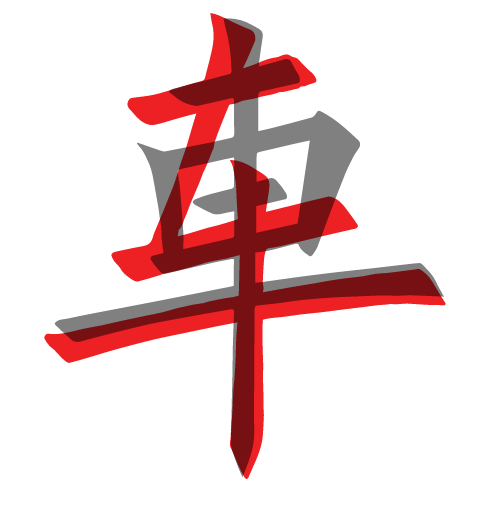
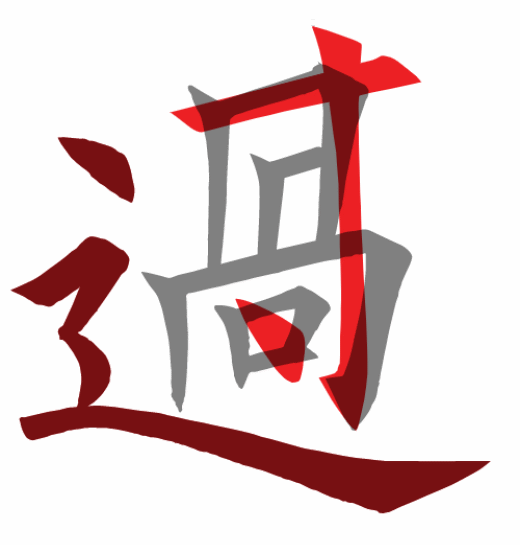

7 comments
It’s a little surprising to see the representation of sounds in modern Mandarin used as a criterion for judging the effectiveness if characters. Is Ash too close to the trees to see the wood? 🤔 Two points spring to mind. The characters were all devised for use with Sinitic languages that were only distantly related to modern Mandarin. (Think of Old High German letters and its inconsistent spelling being used to write modern English.) Secondly, the most obvious feature of modern Mandarin (and some other Sinitic languages) is tones, which are not represented at all by the script. (By comparison, modern Vietnamese script offers an alternative which does reflect this.)
It would have been interesting to see a comparison with Japanese kanji, to provoke thoughts about alternative simplification methods, or to have the adoption of 台 in place of 臺 pointed out – one of the few examples of popular influence coming to bear on the script.
Remember, the context here is ”are simplified characters easier to learn for the modern learner” on a blog called Hacking Chinese, which is aimed at modern learners. Of course, modern Mandarin is going to be used. Why is that surprising?
Very few people learn Chinese characters for a dialect and most of the ones that do already know standard Mandarin. I’m not saying those people don’t exist, but they account for a tiny number of people. Personally, I can read Cantonese (i.e., I know the Cantonese readings for standard characters and know the common dialectical characters), but it’s rare indeed to come across someone else that can read dialect.
If I were discussing the effectiveness in terms of readers from the state of 楚 during Warring States, then obviously, I wouldn’t have chosen Mandarin.
re: “The characters were all devised for use with Sinitic languages that were only distantly related to modern Mandarin”
Given that historical linguistics, specifically, Chinese paleography and Old Chinese phonology are my academic areas of specialty, I’m aware that characters weren’t invented for Mandarin, but I use that as an explanation for why there are sound components that don’t seem to make sense in Mandarin. However, when you’re trying to determine if modern simplifications are easier to learn or not, how do “Sinitic languages that were only distantly related to modern Mandarin” enter into the equation?
I agree that (for the most part) tones aren’t represented in the script, which is why they aren’t important when comparing the sound representation in traditional vs. simplified.
re: “one of the few examples of popular influence”
I’m not sure this is true exactly. A lot of forms that made it into the PRC standard are 俗體, which is exactly “popular influence.” I don’t know the percentages though. That would require more research.
台 vs. 臺 is simple sound loan. 臺 doesn’t have a sound component and the sound component in 台 is rather opaque (厶 is shorthand for 㠯 yǐ and is not related to 厶 sī), so it’s not a good candidate for the current discussion.
I agree with your comment, since I am a beginner, I don’t master a lot of Chinese characters, but I have study a specific field for over 50 years : Alchemy. So everything that is related to energy including Taoist Qigong, Ba Gua, Traditional Chinese Medicine( TCM )and Alchemy was a passion for me.
I have Chinese friends in Taiwan which are related to those field, and they give me a simple example comparing Traditional versus Simplified :
A bottle, in Traditional Chinese, use a pictogram that you see a hand , so you could put something in or remove the content.
In Simplified Chinese this hand was remove. It might be of no significance, but in Alchemy, the Chinese Philosopher or Alchemist use a lot of these hidden symbolist that are completely lost when some literate translate them in Western language.
Sorry I didn’t have access to my library with this Pandemic situation (Over 4500 books), I would have send you some other example. I do have a full loaded Pleco dictionaries in my iPad, but finding a simple word like Bottle, you have so many choices, it is hard to see through all this.
The most frequently used word for bottle is 瓶子, which does not have a “hand” component. I couldn’t find any other words that could be translated as “bottle” that contain one either. But yes, the phenomenon you speak of does exist. The most often cited example is the one in this article: that of 愛 with the missing heart.
I wanted to ask a follow-up question on your first example of an “unsuccessful” simplified character:
>The simplification of 聽 tīng “to listen” is 听: 口 “mouth” + 斤 jīn.
> Why not use 口厅 instead? 口 “mouth” + 厅 tīng
But isn’t the origin of 听 precisely 口 “mouth” + 厅 tīng, with a deformation of 厅 (connection of the two parts; loss of hook at bottom) making it resemble 斤?
The simplification might be deemed “successful” in origin, followed by a slight corruption of form.
Yes, it even says so in his very own Outlier Dictionary, so I’m not sure why that was included.
When I said, “unsuccessful simplification,” what I mean is that the PRC could have easily chosen 口+厅 over 听, but they didn’t. Perhaps if you understand “simplification” in this case as the creation of the PRC standard, then we’d be on the same page. I think it’s quite clear that 口+厅 accomplishes the task of reducing stroke count without damaging sound or meaning representation, while 听 fails at that task. It’s true that it is a slight deformation of form, but it’s a huge deformation of sound (ting vs. jin).